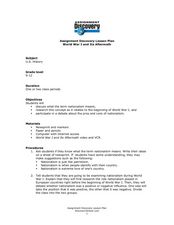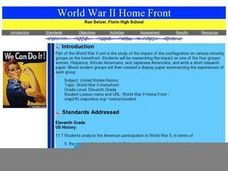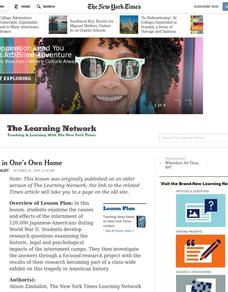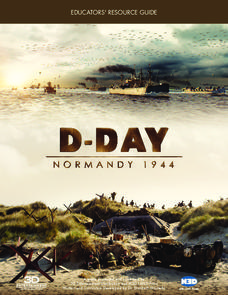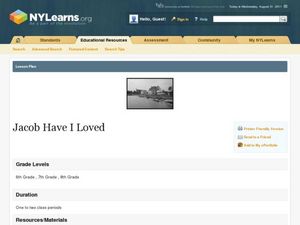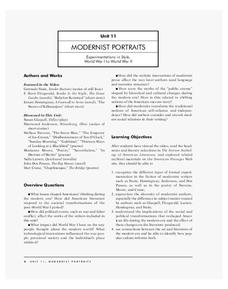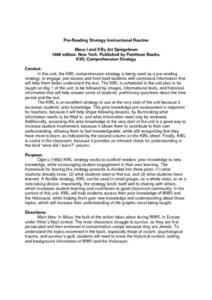Curated OER
World War I and Its Aftermath
Students examine World War I and its consequences. In this World War I lesson, students watch the Discovery video "World War I and Its Aftermath." Students then research how nationalism contributed to the spread of the war...
Curated OER
Learning From World War II and Connecting It to the Present
Compare and contrast World War II to the modern Iraq war with this instructional activity. After watching a film, learners use supporting evidence to support their point of view of the conflicts. Using the internet, they create a...
Curated OER
World War II Home Front
Eleventh graders examine the political demands put on one of four groups living in America during WWII. Each class member is asked to research and write a paper describing the homefront experience for women, Hispanics, African-Americans,...
National Endowment for the Humanities
The House Un-American Activities Committee
Was the House Un-American Activities Committee justified in investigating subversive influences in the entertainment industry? Part two of the three-part series of lessons that examine the anti-communism movement after World War II,...
Curated OER
Primary History: Children of World War 2 Extension Activity- Daily Life
In this World War 2 worksheet, students choose to complete one or more of the three listed extension activities. All activities pertain to daily life of children during World War 2.
Curated OER
The Balkans and World War I
Learners review the causes of World War I and draw timelines of the 1914 events. They conduct Internet research to discover the role of the balkans in the war and how it spread to a worldwide conflict. Students then research the recent...
Curated OER
Prisoner in One's Own Home
Examine the internment of Japanese-Americans during World War II. After reading an article from the New York Times and exploring the author's word choice, young readers find the central idea in the text and work on researching...
Roy Rosenzweig Center for History and New Media
War and Poetry
A band of brothers or the Devil's agents? Nobel warriors freeing the oppressed or mercenaries working for the military/industrial complex? Groups examine poems from the Civil War, World War I, and World War II to determine the poets'...
D-Day Normandy 1944
D-Day Normandy 1944
No study of World War II would be complete without an in-depth examination of the events of June 6, 1944. Pascal Vuong's D-Day Normandy:1944, is the perfect vehicle to convey the sheer magnitude of the events that have been called...
The New York Times
'The Century's Bitterest Journalistic Failure'? Considering Times Coverage of the Holocaust
Rich with primary sources and additional resources, this plan asks class members to think critically about newspaper coverage of the Holocaust. Focusing in particular on the analysis of the article "150th Anniversary: 1851-2001: Turning...
Curated OER
Jacob Have I Loved
Students examine visual images about the novel, Jacob Have I Loved. They compare pictures from "America from the Great Depression to World War II" that are described in the book and other studies of the Chesapeake Bay. They present their...
US National Archives
WWII: The Pacific 1939-45 – Japan and the Atom Bomb
Though the scientists who developed the atom bomb did not believe it should be used to end World War II, American President Harry S. Truman and British Prime Minister Winston Churchill were of like mind in their decision to drop the bomb...
Curated OER
Primary History: Children of World War 2: Growing Up In Wartime
In this history worksheet, students first use the Internet to research and compare schools during World War 2 with those today. Students write a Christmas list of presents for a wartime child in the 1940s.
Curated OER
Facing War
Students visit two sites about World War II. These sites show how war can impact a nation and how people have coped with life during years of war. Particular attention is paid to how the media covers the current war in Iraq.
Teaching English
In Flanders Fields
War is one of the most profound human experiences in history, and is often best depicted in works of art and literature. Introduce class members to the poetry of World War I with this resource that uses John McCrae's "In Flanders Fields"...
Annenberg Foundation
Modernist Portraits
How did literature reflect people's attitudes in post-World War I America? A lesson explores the topic using a variety of activities. Individuals watch and respond to a video; read author biographies and engage in discussion; write...
Curated OER
Maus: Cubing Questioning Strategy
Maus is the text for a postreading activity that has class members using a cubing strategy to analyze, in depth, topics (racism, past and present, forgetting/remembering the Holocaust, representing the Holocaust) associated with Art...
Curated OER
Night: Socratic Questioning Activity
We construct meaning through discussion, so help your readers of Elie Wiesel's work Night with a socratic questioning activity. The strategy is outlined on the first page, and the second page offers some example questions you give to...
Curated OER
End of World War II
Ninth graders examine the results of the Yalta Conference on Europe after the war. They develop a PowerPoint presentation that compare the effects of World War I and World War II. They write a journal entry taking the point of view of...
Maryland Department of Education
The Concept of Identity Lesson 8: Propaganda in Visual Media
Visual and print propaganda are featured in a lesson that asks readers of A Separate Peace to examine the techniques used in propaganda from World War I, World War II, presidential elections, and in the novel.
Curated OER
Journey to Topaz: KWHL Strategy
Japanese Internment and World war II are the focus of a KWHL strategy used to scaffold for a reading of Journey to Topaz, Yoshiko Uchida's story of 11-year-old Yuki Sakane and her family. Complete directions for the activity...
Curated OER
KWL Comprehension Strategy: Maus I and II
How much does your class know about World War II? Before reading Art Spiegelman's Maus I, lead your class in creating a KWL chart. Knowing the background and setting of the novel are extremely important in understanding this survivor's...
Curated OER
Primary History: Children of World War 2
In this history reflection worksheet, students use the prompt to write an essay comparing the experiences of a World War 2 evacuee and a newcomer coming to live in a strange country. Prior knowledge of the Pied Piper evacuation during...
Curated OER
Primary History: Children of World War 2- Air Raids
In this history worksheet, students make a model of an Anderson air raid shelter from World War 2. Students write a diary entry about one night in an air raid shelter. There is no historical information on this page and research will be...
